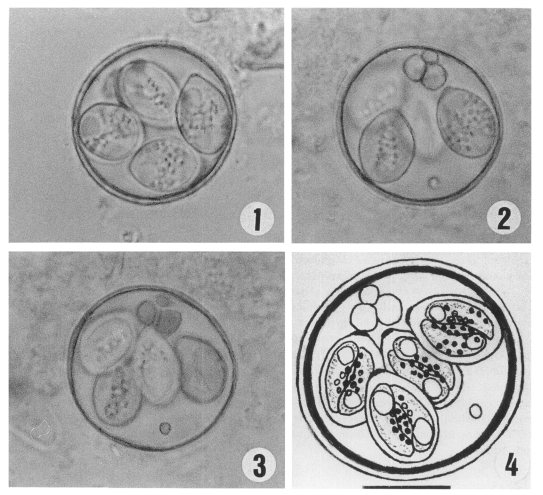INTRODUCTION
To date 17 eimerian species have been described from chiropterans worldwide (Duszynski and Barkley, 1985; Duszynski et al., 1988; Duszynski, 1997; Scott and Duszynski, 1997), but only two species of Eimeria have been reported from members of the genus Pipistrellus; E. macyi from Pipistrellus subflavus from USA (Wheat, 1975) and E. redukeri from P. javanicus from Japan (Duszynski, 1997).
No Eimeria species has been described from Pipistrellus kuhlii, herein we describe a new species of Eimeria from P. kuhlii from Shagrah, Saudi Arabia.
MATERIALS AND METHODS
Twelve bats, P. kuhlii (Natterer, 1819) were trapped alive at Shagrah during November, 1997 with the aid of mist nets. All bats were killed in the laboratory, and the abdominal cavity was opened. The intestinal tract, caecum, rectum and colon were slit lengthwise, and their contents were collected separately and mixed with 2.5% (w/v) aqueous potassium dichromate solution to inhibit bacterial growth. The suspension was then spread in a thin layer in petri dishes and incubated at 26 ± 2℃ for 1 week so that the oocysts could sporulate. The preparations were then microscopically examined for sporulation at 12 hr intervals. Sporulated oocysts were concentrated by flotation with Sheather' sugar solution (McAllister et al., 1995). Fifty sporulated oocysts and 50 sporocysts were examined, and measured with a microscope fitted with a ×100 apochromatic oil immersion objective and a ×10 ocular micrometer. The number of layers of the oocyst wall, its thickness, and detailed structure of the sporocysts were examined after crushing the oocysts by pressure on the coverslip. All measurements are in micrometers (µm) with the mean followed by the range in parentheses.
RESULTS
Eimeria pipistrellus (Figs. 1-4) Description
Oocyst wall 1.2-1.5 (1.3) thick consisting of 2 layers of approximately equal thickness; outer, light brownish-yellow, smooth; inner dark, smooth; a micropyle is absent, but an oocyst residuum, consisting of one to three large globules, 5.2 (4.5-6.0), and a polar granule approximately 1.6 both are present. Sporulated oocysts (n=50) subspheroidal 24.8×23.2 (22-27×20-25) with L:W ratio 1.0-1.2 (1.06). Sporocysts ovoidal, slightly pointed at one end, 11.6×8.3 (10.5-13×7.5-9) with L:W ratio 1.4-1.5 (1.45), Stieda body present, but sub- and parastieda bodies absent. Sporocyst residuum present as numerous minute dispersed granules. Sporozoites elongate, lying head to tail, each with one large posterior refractile body.
Taxonomic summary
Type host: Pipistrellus kuhlii (Kuhl, 1819) Vespertilionidae
Type locality: Shagrah, central region, Saudi Arabia
Prevalence: Found in three of twelve (25%) P. kuhlii.
Site of infection: Unknown, oocysts recovered from intestinal contents.
Sporulation time: Six days at 26 ± 2℃
Etymology: The specific name Pipistrellus is derived from the generic name of the host.
Type specimens: Oocysts in 10% formalin and a phototype are deposited in the Parasitological Collection, Department of Zoology, College of Science, King Saud University, Riyadh, Saudi Arabia both as KSUC 105.
DISCUSSION
Only two species of Eimeria have been described previously from the genus Pipistrellus (Vespertilionidae), E. macyi (Wheat, 1975) and E. redukeri (Duszynski, 1997). Eimeria pipistrellus n. sp. differs considerably from both of the above mentioned two species in having a larger oocyst with smooth outer wall. Moreover, E. pipistrellus can be distinguished easily from E. macyi because it has an oocyst residuum and lacks a substiedal body, and from E. redukeri in having a larger oocyst residuum composed of one to three large globules, in having larger sporocysts with smaller length/width ratio, and in having small, dispersed granules as a sporocyst residuum rather than only one to three large globules seen in the sporocysts of E. redukeri.
These differences in structural features, geographic distribution, and host species make us suggest that E. pipistrellus is a distinct form.







